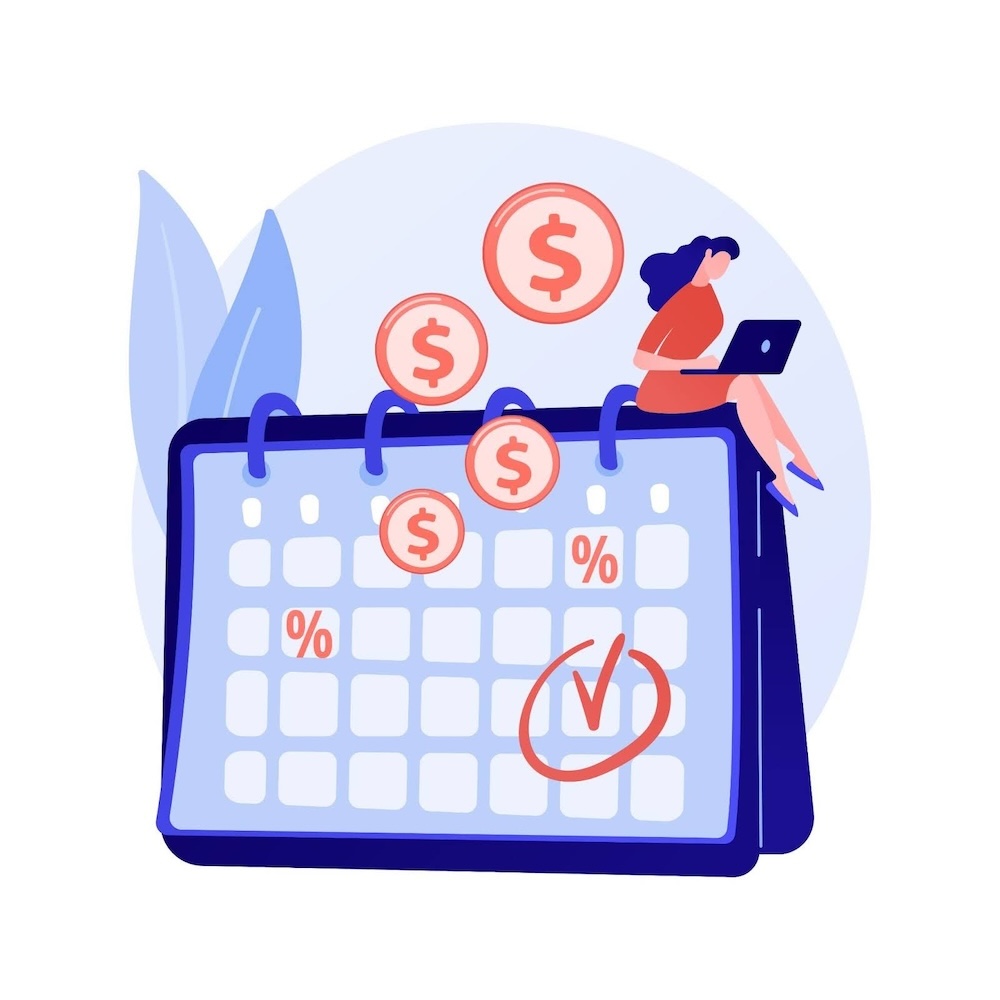
A common misconception about sales is that the bulk of the work gets done on calls or in cold outreach emails. That’s where the majority of sales advice and training focuses, and it’s also where newcomers to the industry can get tripped up—because the real magic happens in the follow-up.
When you think about it, it makes sense. It’s not every day that decision-makers are ready to commit on the first call or point of contact, especially in today’s hyper-saturated business landscape where there’s always another offer or deal waiting just around the corner. It’s the following up that separates the wheat from the chaff. That’s the point in the sales process where skilled salespeople nurture demonstrations of interest into decisions, where relationships are built, and often where the deals themselves are closed.
But just because it’s important doesn’t mean it’s easy. As it happens, follow-ups are a huge potential sticking point. Salespeople need to tread a delicate balance. Come off too aggressive, and you risk pushing the prospect away. On the other hand, if you’re too passive or low energy, you run a real risk of losing the opportunity altogether, either because they lose interest in your offer or get nabbed from under your nose by a competitor.
In the following article, we’ll be diving into the nuanced world of sales follow-ups, offering strategies, insights into timing, and a balanced perspective on how to nurture leads effectively and drive more successful outcomes.
The Art of the Follow-Up
The best way to think of a follow-up strategy is as a cohesive, multifaceted process that comprises several different key moments, each of which requires their own approach. Every single touchpoint is a potential opportunity to usher the deal closer to completion, but it’s also a chance to slip up and harm the possibilities of a successful close.
Basics First: Sales Activities
The most important part of building out a well-crafted follow-up strategy actually takes place before any following-up even happens. We’re talking about designing the sales activities your team is going to be using to guide them throughout the whole process.
The most successful sales teams, no matter what company they’re a part of, all have one thing in common. They follow the same blueprint and work together as a cohesive unit.
Depending on the specific product or service you’re selling, your sales activities are going to look slightly different, so there’s no cookie-cutter solution that every sales team in every industry can follow and expect to have success with. This is where technological tools can be used to your advantage.
Customer Relations Management systems like noCRM make it easy to create different sales activities and customize them to slot in perfectly with your unique sales process. As an illustrative example, check out just how easy it is to set up unique sales activities in noCRM:
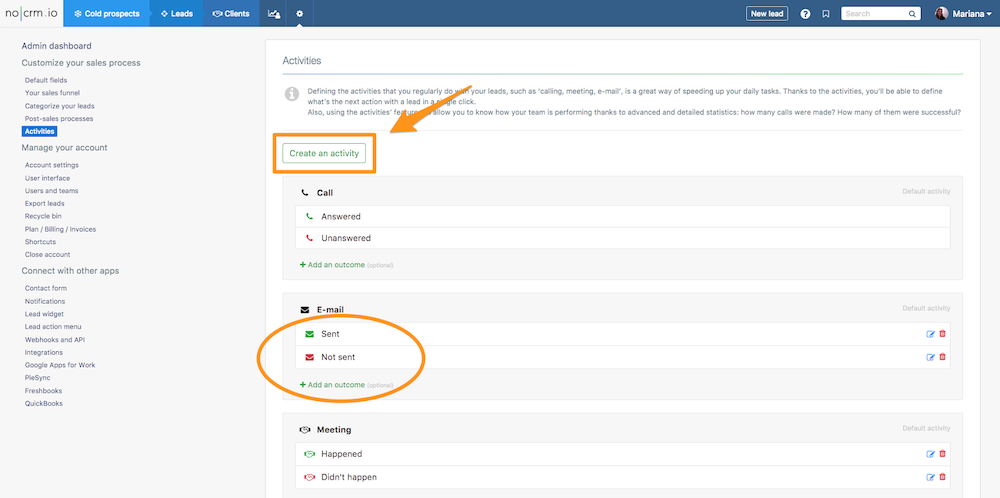
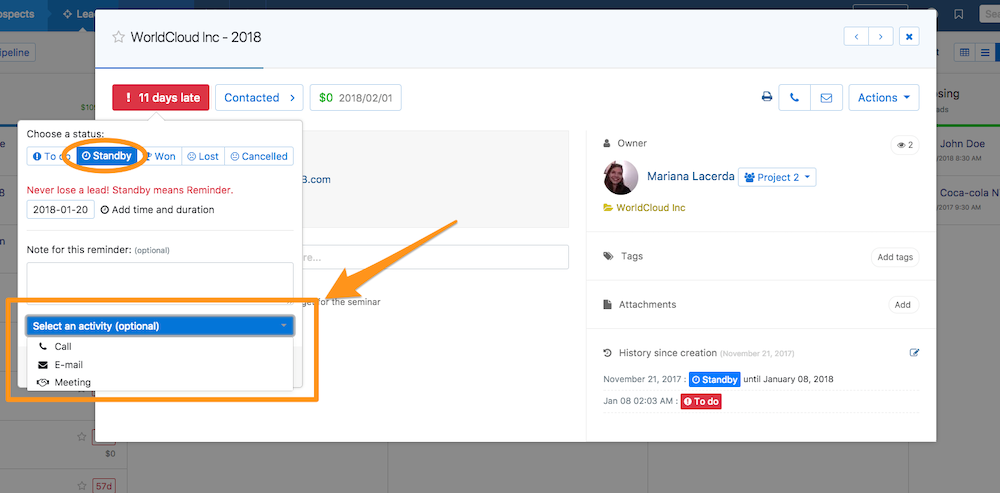
Initial Outreach: Setting the Tone
The first follow-up, which typically takes the form of an email or call, should come shortly after the initial contact or meeting. Depending on how that first contact happened, your approach will vary accordingly. There’s no point in following up with a call if you said in your email you’d get back to them with a proposal, after all.
But no matter how you decide to reach out and make that initial follow-up contact, you’re going to want to focus on setting the tone for the ongoing relationship. It’s not just a question of reminding the prospect that you exist—it’s about beginning to add value right from the word ‘go’. Summarize key points you discussed in your initial point of contact, provide any additional information that was requested by the prospect, and propose next steps.
These will all go a long way towards cementing the idea of yourself as a trustworthy, credible operator the prospect can look forward to building a relationship with. The ideal tone should be professional while remaining warm and approachable, showing you’re not just about the sale, but about making an ongoing connection that can be relied on in the future.
All of this is great, of course, but if you forget to follow-up shortly after the first contact, you’ll ruin all the good work you might’ve been able to do in the future. The best way to prevent this from happening is with automated follow-up reminders. Ideally, the reminders should be specific to the deal at hand and provide as much detail as possible, so that when you get that notification, you’re already prepped with everything you need to know.
noCRM allows you to do exactly that, but it goes one step further too. With noCRM, follow-up notifications are actually mandatory, if the deal hasn’t been marked as either lost or won, making it essentially impossible to forget to follow-up, since every single activity will come with its own reminder as a matter of necessity. Here’s what that actually looks like in practice:
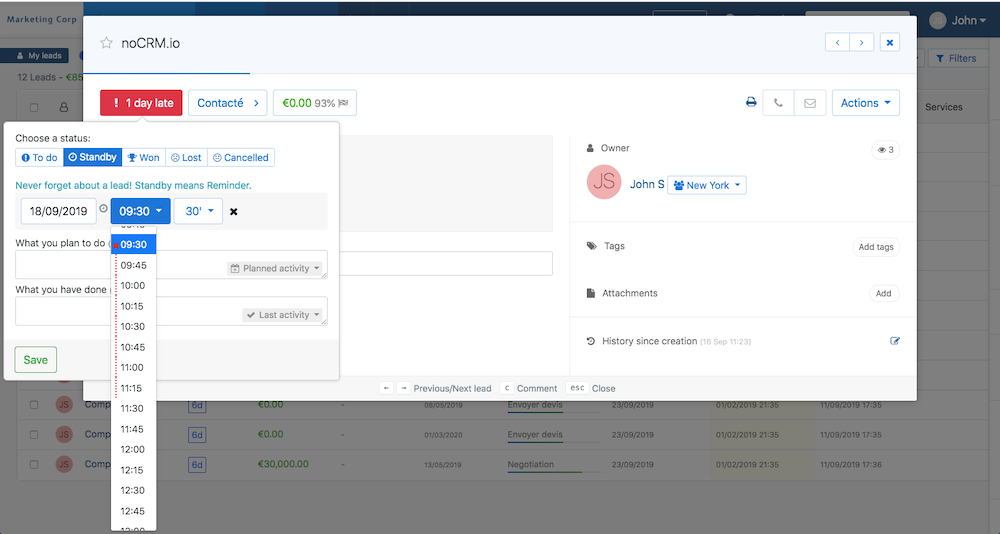
Ongoing Communication: Keeping the Prospect Warm
In an ideal world, every single follow-up would be met immediately with an enthusiastic response. Unfortunately, we don’t live in an ideal world, and the practical reality of the situation is that plenty of times, your follow-up email or call will be met with deafening silence.
If this happens, don’t despair. It’s all part of the process, and it can actually be viewed in a positive light, since it gives you the opportunity to add even more value and keep the prospect as warm as possible.
It can be tempting to want to get in touch right away, but don’t follow your first instinct to rattle off an immediate, next-day continuation of your communication. In most cases, that’ll only serve to irritate the prospect and ruin any chances of them having a positive association with your company. Have faith in the value-add of your offer and your own strength as a salesperson, and give the messaging chain a few days to simmer before jumping back in.
And when you do follow-up again, make sure to focus on adding value above all else. This is a seriously tricky part of the process for even the most experienced of salespeople, but the goal remains the same for everybody—building trust by sharing useful information. The information itself can take several different forms, from an insightful article or an industry-relevant case study to an invitation to a webinar your company is hosting.
The core concept to focus on is being useful without providing an overt sales pitch. Don’t be afraid to send a few of these if the first one doesn’t get a bite, but always remember not to spam the prospect and to leave at least a day or two between communications.
Again, technological tools are in your corner at this point in the process. You’ll probably have moved your prospect to a certain stage in your pipeline—somewhere after initial follow-up but before a further demonstration of interest. To make sure you can keep yourself organized across multiple different prospects in multiple stages, it’s vital your CRM has an intuitive, straightforward way to progress deals through the stages.
Check out how easy that is to do with noCRM:
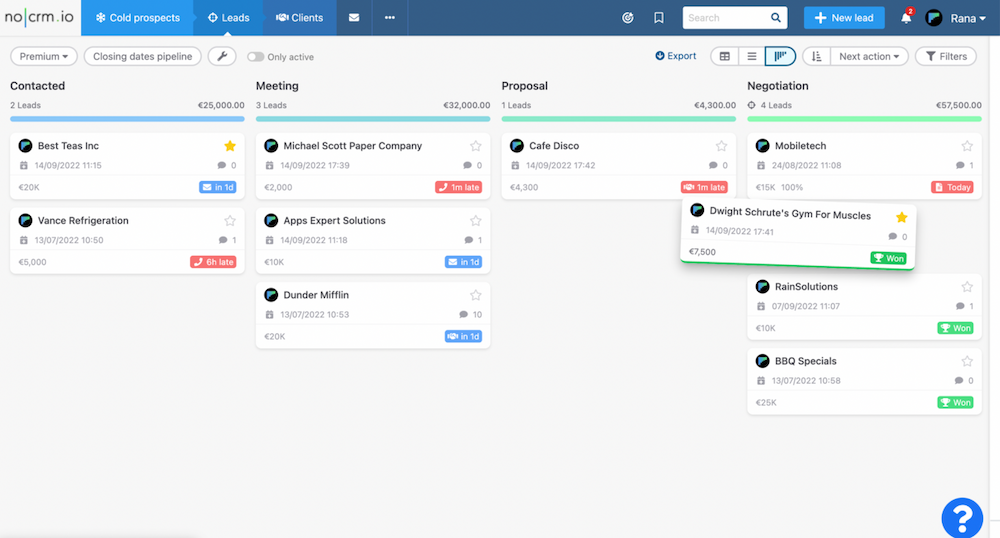
If the first follow-up is met with silence, don’t retreat. Instead, prepare for the second movement. Here, your goal is to reinforce the connection by offering something of value. Share an insightful article, a case study relevant to their industry, or an invitation to a webinar your company is hosting. The key is to provide value without an overt sales pitch.
Elevating Interest
A week or two after the initial contact is a vital moment in the sales process. If the prospect hasn’t responded to your first two or three follow-ups, chances are the deal is dead in the water. It’s bad news, but it’s part of life in the world of sales, and it doesn’t necessarily mean you should give up completely.
You can continue to reach out sporadically and add value, but you should be prepared to accept that it might not go anywhere, and you’ll probably also want to devote your time to more promising deals in your pipeline.
On the other hand, assuming the prospect has responded positively to one of your follow-up attempts, now it’s time to get serious. Your job at this stage is to elevate the prospect’s interest as much as possible. After all, you already know the interest is there, so to whip it up even further you need to make your offer as compelling as you can.
This is the perfect time for a more personalized approach to following up. There are a few different ways to go about this, and the exact method you choose will vary depending on your industry and the product or service you’re selling, but two of the most common techniques include a tailored demo, or a detailed proposal that addresses the prospect’s specific needs.
Each of these are time-consuming, of course, but that’s okay. Investing time at this stage is likely to pay dividends when the deal finally closes down the line.
Crescendoing the interest is all about showing you’re not just following up, you’re deeply invested in providing solutions that resonate with their unique challenges. You can expect to have built a degree of trust by this point in the relationship, and it’s time to start leveraging that trust to drive a successful sales outcome.
The Final Act: Nudging Towards Closure
As you’ve continued to build trust and add value over the days and weeks following your initial contact, it’s time to get serious and start thinking about closing. By this point, all your follow-ups should be gently nudging the prospect towards a decision. It’s not the time for dilly-dallying. If you’re confident in the trust you’ve created and the offer you’ve crafted to respond to their unique problems, you need to be bold and more aggressive in how you pitch that solution.
At the same time, it’s important you don’t show disrespect for the prospect’s decision-making process. We all make business decisions differently, and while hesitation might demonstrate a lack of trust in one prospect, it could well signify that another is simply interested in taking the time they need to be sure of the choice they’re making. But it’s possible to respect their own process while still starting to ask for their business more directly.
Start framing your communications from a perspective of addressing final questions or any lingering concerns they might have about your product or service. Specific language choices that imply a conclusion of the process can do a lot of the heavy lifting in this regard.
Continue to add value and to address their concerns, but push more and more as you edge towards closing the deal. This can also be a great time to leverage any discounting authority you might have within your organization. Often, a final push is all it takes to turn a red-hot prospect into a closed deal.
Conclusion
Following up offers a world of potential to salespeople, but it’s also packed with potential pitfalls. From being too aggressive in the early stages before value has been added or trust has been built, to being too passive once the prospect shows signs of wanting to close, there are myriad ways to trip up and lose out on potential deals.
But by breaking the process down into actionable stages, each with their own set of challenges and goals, you’ll be able to keep focused on the broader picture at every step of the way and drive more successful outcomes from the prospects you’re dealing with.
And of course, technological support is nothing short of vital in today’s business landscape. What you really need to complement a reliable follow-up process is hands-on support from your CRM of choice. Whether that’s creating unique sales activities, taking the busywork out of follow-ups with mandatory automated reminders, or simply moving your prospects through your pipeline, noCRM offers a complete suite of lightweight, user-friendly features designed to help salespeople at every stage of their career close more deals.
Why not try it out today and see for yourself the difference it could make to your sales success?
FAQ
Following up is crucial because it helps turn initial interest into decisions, build relationships, and close deals. It’s key to keeping prospects engaged and addressing their needs.
Effective strategies include setting a professional tone, providing valuable information, and personalizing communication with tailored demos or proposals. Consistent and timely follow-ups are essential.
Technology, like noCRM, helps automate reminders, organize activities, and track interactions, ensuring timely and personalized follow-ups that are less likely to be missed.


